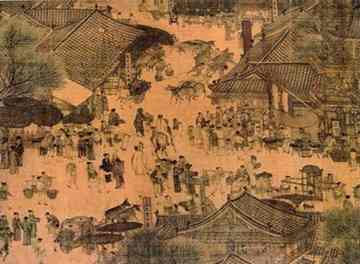Kaifeng — the city portrayed in the painting Along the River During the Qingming Festival — created an urban model 1,000 years ago that many later dynasties followed.
 The famous painting, Along the River During Qingming Festival, impresses visitors at the China Pavilion not just because of the animated figures in the electronic version of the painting but because it shows a prosperous view of Kaifeng, capital of the Northern Song Dynasty (960-1127). It also showcases the wisdom of city planning in ancient China.
The famous painting, Along the River During Qingming Festival, impresses visitors at the China Pavilion not just because of the animated figures in the electronic version of the painting but because it shows a prosperous view of Kaifeng, capital of the Northern Song Dynasty (960-1127). It also showcases the wisdom of city planning in ancient China.
With archaeological excavations and research in recent years, China's urban history has been rewritten over and over. Indeed, urban relics have been found not only in the Yellow River region, but in the Yangtze River region and elsewhere.
The governments of the Xia (2100-1600 B.C.), Shang (1600-1100 B.C.) and Zhou (1100-256 B.C.) dynasties implemented enfeoffment systems, by which officials were given land in exchange for a pledge of service. In this way, each city enjoyed relative independence and administrative functions were focused mostly on urban planning. The most important part of the cities was dominated by the palaces of noble people and officials as well as administrative and ritual sites. Cities were normally surrounded by city walls and some even had defensive fortifications. Most cities were very large and even contained farmland within them.
From a modern perspective, ancient cities were not particularly well planned. However, for their time, they met the needs of the people, especially since they needed city walls and defensive fortifications to ensure their safety.
After the Qin Dynasty (221-206 B.C.), the enfeoffment system was replaced by a centralized system and the political functions of the cities became more evident. In the Western Han Dynasty (206 B.C.-25 A.D.), more than 1,500 towns nationwide were stratified into several administrative levels; each town was controlled by the higher level. Each city had its administrative bodies and set up city walls. Political bodies and city walls were two essential elements of cities in those days.
Chang'an, capital city of the Western Han Dynasty, was built on the ruins of the Qin Dynasty. One third of the city was occupied by the palaces of the emperor, another one third was dominated by warehouses, government offices, barracks and prisons, so only one third of the city's land was left for ordinary people. The same structure also applied to Luoyang, capital of the Eastern Han Dynasty (25-220).
 In regular cities, although they didn't have big palaces, government offices and other administrative institutions also occupied most of the land in the city. Therefore, the quality of life for the common people in cities was not as good as in rural areas.
In regular cities, although they didn't have big palaces, government offices and other administrative institutions also occupied most of the land in the city. Therefore, the quality of life for the common people in cities was not as good as in rural areas.
In an agricultural society, many people work on farms and don't want to leave their hometown. Except for those who originally lived in cities or had to live there—such as the emperor, nobles, officials and businessmen—people preferred to live in the countryside.
At the end of the Eastern Han Dynasty, the country was divided into several parts and suffered from continuous civil war, which brought great damage to cities. At the same time, war forced many people to move to the cities from rural areas, thus increasing the population of urban areas and making them more culturally diverse.
At the same time, with the introduction of Buddhism to China, temples became necessary elements in cities.
Taking Luoyang, capital of the Northern Wei Dynasty (386-534), as an example, records indicate that about 1,000 temples were built in the city; also, Luoyang attracted many businessmen from neighboring countries.
Chang'an, capital of the Tang Dynasty (618-907), already had various functions. It focused more on business. Occupying more than 80 square km, Chang'an was one of the largest and most populous cities in the world at that time. But the closed structure of the city still put some limitations on its commercial and economic development.
These limitations were finally overcome in the Song Dynasty (960-1279), as shown in the painting Along the River During the Qingming Festival.
The urban area of Kaifeng, reflected in the painting, spread beyond the city's walls to suburban areas and the city's commercial development offered more convenience to residents.
Meanwhile, developed transportation made it much easier for people to go to cities and promoted more communication between urban and rural areas.
According to Chinese and foreign historians, economic and cultural development during the Song Dynasty reached a higher level than in any previous dynasties in China. This can be seen in the painting. Subsequently, this model of urban planning was adopted by other cities in later dynasties, such as cities in the Yangtze River region.
Shanghai similarly took advantage of ideas from other cities, as part of its development. Using the experience of other cities and people from many different places, Shanghai has now developed into a booming international metropolis.
Author: Ge Jianxiong | Source: Beijing Review [October 11, 2010]